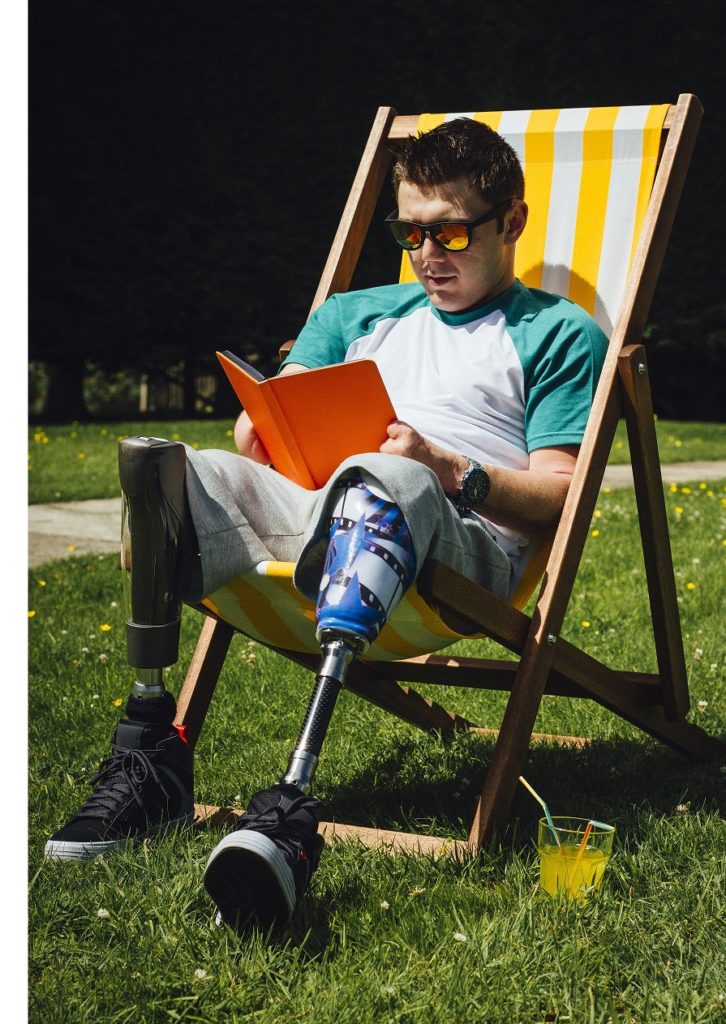We’re constantly hearing great amputee stories—way more than we have the capacity to chase down, write up, and share in the magazine or at the website. Our file has gotten especially thick lately, so we decided to set the best items out and let you sift through the buffet.

We begin with an incredible story out of Great Britain that’s been unfolding for nearly a month. A five-year-old kid named Tony Hudgell has raised almost half a million pounds so far for the hospital that saved his life, Evelina Children’s Hospital in London. He lost both legs due to nightmarish abuse he suffered as an infant. Now safely placed with an adoptive family, Tony is learning to walk on a new pair of prostheses and set himself the challenge of logging 10 kilometres by the end of June. He’s reached 5 kilometers so far, piling up funds for Evelina with every step. Details at the Daily Mail; here’s where you can make a donation.
If you liked that story, you might also enjoy reading about 10-year-old Maisie Catt’s similar funder from last month to raise money for LimbPower. Both she and Tony were inspired by Captain Tom Moore, a 100-year-old British Army veteran who’s raised more than ₤30 million for Britain’s National Health Service by walking laps in his garden.
The quest of multisport Paralympic hopeful Roderick Sewell resonated with us for multiple reasons, but mostly for how it depicts amputees’ genius for adaptation. When the pandemic disrupted Sewell’s training in the pool (he’s a specialist in the breaststroke), he took the down time as an opportunity to elevate his game in cycling to world-class standards. Given an extra year to prepare due to the Games’ postponement to 2021, Sewell’s allowed himself to dream of medalling in both disciplines. True to Patrick Quinn’s observations from back in March, Sewell is making the most of what he has, not dwelling on what he’s lost.
Having just written about Fair Insurance for Amputees last week, we took note of this great piece of self-advocacy by Ali Ingersoll over at PUSH Living. A quadraplegic, Ingersoll was denied coverage by Blue Cross Blue Shield for one particular function (a seat elevator) on her new wheelchair, for seemingly arbitrary reasons. Sound familiar? Ingersoll fought a similar battle with BCBS five years ago and prevailed with logic, heart and sheer determination. We wouldn’t bet against her in the rematch. She’ll be posting updates as the situation progresses.
This month’s InMotion Magazine from the Amputee Coalition surveyed the history of prosthetics, a subject in which we’ve dabbled here from time to time. There’s practically a whole category’s worth of Jeopardy! clues in this article. “I’ll take Prosthetics and Progress for $200, Alex.“ “The answer is: These ancient pyramid builders prayed to an amputee god with an obsidian foot“….“P&P for $600.” “The modern above-knee prosthetic leg traces its design to a 16th-century royal surgeon from this country”….”Final clue in the category, for $1000: The oldest surviving leg prosthesis dates to 300 BC from this Mediterranean nation.” Buzz in if you know the correct responses (and be sure to phrase them in the form of a question), or get them in the article, which starts on page 32.
A couple of recent stories out of Africa made us smile. One tells the tale of Shafik Ssebuuma, a rising talent in amputee football who’s putting Uganda’s national team on the map. Ssebuuma worships the Portuguese star Cristiano Ronaldo and is said to emulate his idol’s speed and imagination on the pitch; he simply does it on crutches. Then there’s this item about Mary Oluchi Micheal, better known as “The Minister of Happiness” in her native Nigeria and on Instagram. Happiness didn’t come naturally to Micheal after arteriovenous malformation (AVM) resulted in amputation below the right elbow, followed by chronic pain, social stigma, and emotional struggles through adolescence. But she committed to putting those demons behind her. Now 25, she’s married, a happy parent, and a millionaire who spreads the love.
Amplitude’s sister publication, O&P Edge, delves into the growth of telehealth in prosthetic care and the hurdles practitioners have to surmount to get this service up and running. It’s a bit more complicated than simply creating a Zoom account. But given what everyone’s been through this spring, the ongoing trend toward social distance, and the possibility of future virus-related shutdowns, the need for telehealth prosthetist care is growing. We gave you one patient’s perspective on telehealth not long ago. Here’s how things look from the clinicians’ point of view.
Finally, the current issue of Challenge Magazine listed the top 10 states for adaptive sports, based on input from readers and adaptive athletes. It’s not much of a spoiler to tell you Colorado and California occupied the top two spots (although we’re not saying in which order). But the rest of the list includes a few states that might surprise you. Click through and scroll to page 22 to see if your state made the cut.